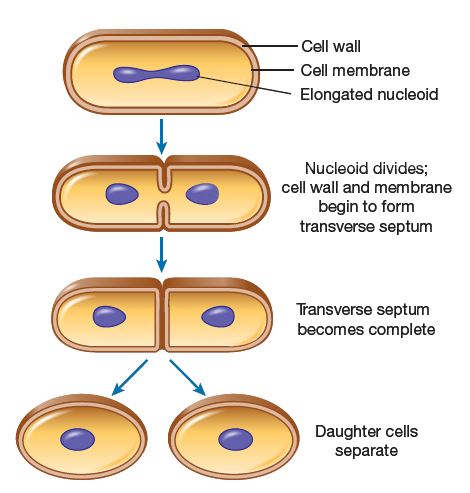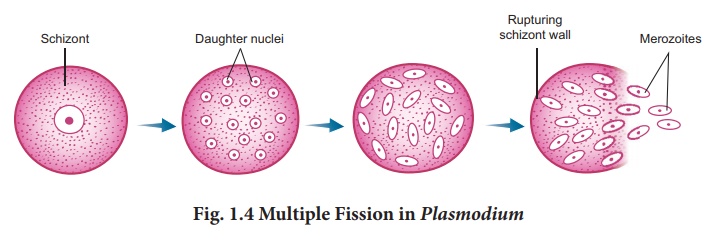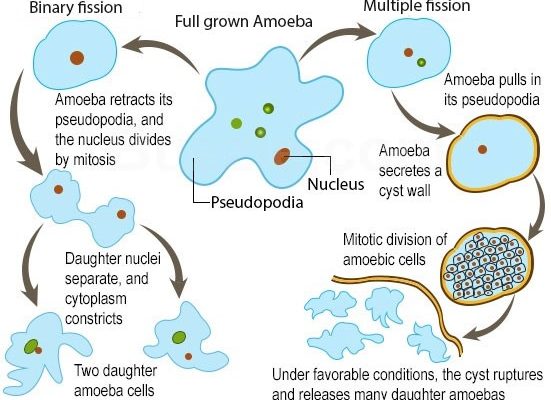Asexual Reproduction is a type of Reproduction that involves the production of offspring without the involvement of Gametes or fertilisation. Binary Fission and Multiple Fission are two different types of Asexual Reproduction that occur in different organisms.
Binary Fission is a form of Asexual Reproduction in which a single Cell Divides into two identical daughter cells. This type of Reproduction is commonly observed in single-celled organisms, such as bacteria and protozoans.
Multiple Fission, on the other hand, is a type of Asexual Reproduction in which a single parent Cell Divides into multiple daughter cells. This process is observed in some multicellular organisms, such as certain algae and some parasites.
Table of Contents
How does Binary Fission Differ from Multiple Fission
8 Important Differences between Binary Fission and Multiple Fission
| Aspect | Binary Fission | Multiple Fission |
|---|---|---|
| Definition | Produces two identical daughter cells from a single parent cell. | Produces multiple daughter cells from a single parent cell. |
| Cell Division | Parent cell divides its genetic material and divides into two identical daughter cells. | Parent cell undergoes multiple rounds of Cell Division to produce multiple daughter cells. |
| Timing | Occurs when the parent cell has grown large enough to divide. | Occurs in response to specific environmental cues or signals. |
| Daughter Cell Number | Produces two identical daughter cells. | Can produce many daughter cells, sometimes dozens or hundreds. |
| Examples | Observed in bacteria and some protozoa. | Observed in some algae and parasites like Plasmodium. |
| Genetic Variation | Produces genetically identical daughter cells. | Can result in some genetic variation due to the possibility of mutations occurring during the replication and division of the genetic material. |
| Cell Size | Parent cell typically divides into two equal-sized daughter cells. | Can produce daughter cells of varying sizes, with some being much smaller than the parent cell. |
| Mechanisms | Involves a relatively simple process of DNA replication and Cell Division. | Involves complex cellular and molecular mechanisms, including the formation of multiple nuclei and the partitioning of the cytoplasm to form individual daughter cells. |
| Diagram |  |  |
How does Binary Fission Differ from Multiple Fission – Detailed Explanation
How does Binary Fission Differ from Multiple Fission in terms of Process ?
- In Binary Fission, the parent Cell duplicates its genetic material and divides into two identical daughter cells. The process of Binary Fission involves the replication of the genetic material, followed by the division of the parent cell into two daughter cells.
- In Multiple Fission, the parent cell undergoes multiple rounds of division to produce multiple daughter cells. The process of Multiple Fission involves the replication of the genetic material and multiple rounds of Cell Division, leading to the formation of many daughter cells.
How does Binary Fission Differ from Multiple Fission in terms of Timing ?
- Binary Fission occurs when the parent cell has grown large enough to divide. The timing of Binary Fission is determined by the growth rate of the organism and the availability of nutrients.
- Multiple Fission occurs in response to specific environmental cues or signals. The timing of Multiple Fission is determined by external factors, such as changes in temperature, light, or nutrient availability.
How does Binary Fission Differ from Multiple Fission in terms of Daughter Cell Number ?
- Binary Fission produces two identical daughter cells, whereas Multiple Fission can produce many daughter cells, sometimes dozens or hundreds.
- The number of daughter cells produced in Multiple Fission depends on the organism and the specific conditions that trigger the process.
- For example – some algae can produce hundreds of daughter cells through Multiple Fission, while others may only produce a few. In contrast, Binary Fission always produces two identical daughter cells.
How does Binary Fission Differ from Multiple Fission in terms of Genetic Variation ?
- Binary Fission produces genetically identical daughter cells that are clones of the parent cell. This lack of genetic variation is both an advantage and a disadvantage. On one hand, it ensures that the offspring are well-adapted to the parent’s environment. On the other hand, it can make the population vulnerable to environmental changes, diseases, and parasites.
- Multiple Fission can result in some genetic variation due to the possibility of mutations occurring during the replication and division of the genetic material. This can be advantageous for the population as some offspring may have traits that are better suited to new or changing environments.
How does Binary Fission Differ from Multiple Fission in terms of Cell Size ?
- In Binary Fission the parent cell typically divides into two equal-sized daughter cells. This is because the genetic material is duplicated and then divided evenly between the two cells.
- Multiple Fission can produce daughter cells of varying sizes, with some being much smaller than the parent cell. This is because the parent cell undergoes multiple rounds of division each time producing smaller daughter cells. The variation in cell size can be advantageous in some cases, as it allows for the production of a range of cell sizes with different functions.
How does Binary Fission Differ from Multiple Fission in terms of Mechanisms ?
- Binary Fission involves a relatively simple process of DNA replication and Cell Division. The genetic material is duplicated, and the cell then divides into two identical daughter cells .
- Multiple Fission involves complex cellular and molecular mechanisms, including the formation of multiple nuclei and the partitioning of the cytoplasm to form individual daughter cells. This makes Multiple Fission a more complex process than Binary Fission, and it requires more energy and resources from the parent cell.
Examples of Binary fission and Multiple Fission
Binary Fission – Examples
Binary Fission is a type of Asexual Reproduction that occurs in many unicellular organisms. In binary fission.The parent cell divides into two identical Daughter Cells. FOllowing are few examples of Binary Fission –
- Bacteria – Bacteria are perhaps the best known examples of organisms that reproduce by binary fission. They divide into two equal parts, each containing an identical copy of the parent cell’s DNA.
- Amoeba – Amoebae are single-celled eukaryotes that reproduce by Binary Fission. They first replicate their DNA and then divide into two daughter cells.
- Paramecium – Paramecium are Unicellular organisms that use Binary Fission to reproduce. During fission the organism divides into two daughter cells that are genetically identical.
Multiple Fission – Examples
Multiple Fission is a type of asexual reproduction that occurs in some protists, fungi and algae. In multiple fission the parent cell divides into multiple daughter cells simultaneously. Following are few examples of Multiple Fission –
- Plasmodium– Plasmodium is a unicellular protozoan parasite that causes malaria in humans. It reproduces through multiple fission in which the parent cell divides into multiple daughter cells called merozoites.
- Sporozoans– Sporozoans are a group of parasitic protozoans that reproduce by multiple fission. They produce multiple daughter cells called sporozoites that can infect new host cells.
Also Check – 15 Important Differences between Unicellular and Multicellular organisms
Also Check – 9 Important Differences between Sexual and Asexual Reproduction
Also Check – 16 Important Differences between Prokaryotic and Eukaryotic cell


2 Comments on “How does Binary fission Differ from Multiple Fission”